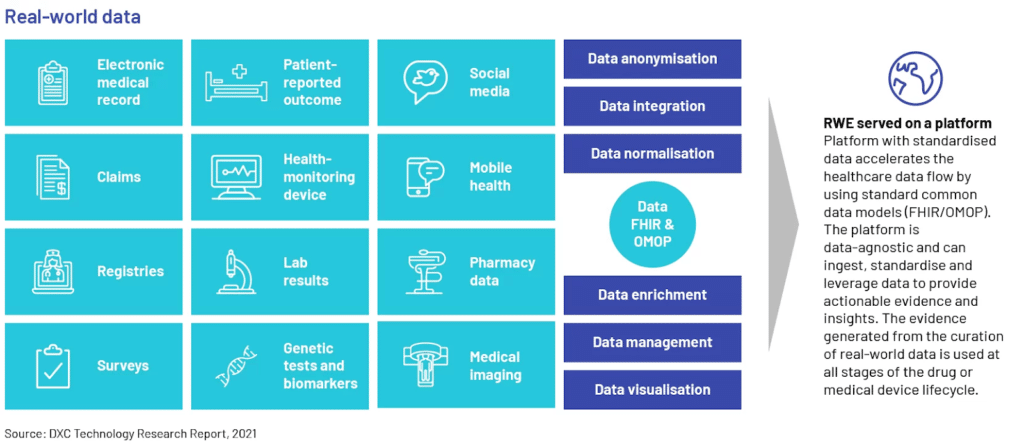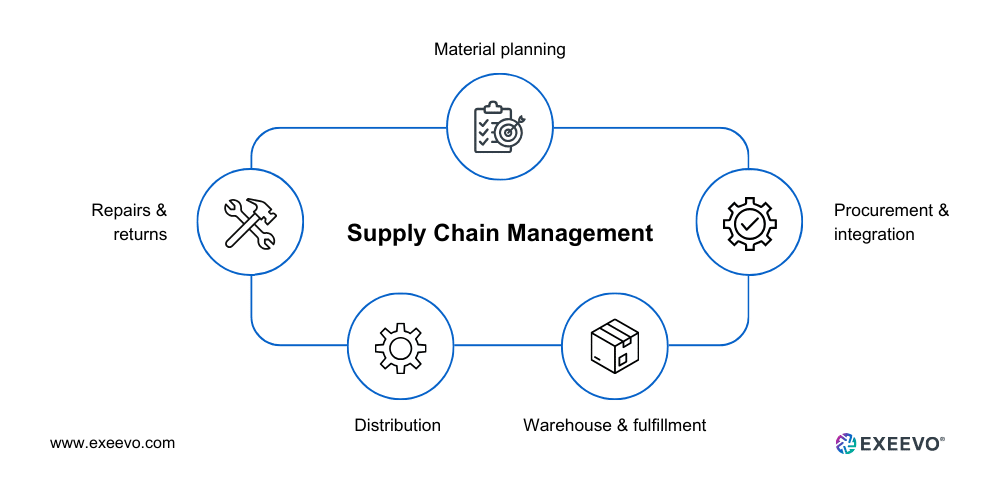The rise of new technologies is reshaping the Life Sciences industry. These emerging technologies are opening doors for unprecedented opportunities.
In 2023, healthcare payer CIOs are focusing on driving growth, modernizing technology and enhancing the consumer experience. For CIOs, it’s essential to comprehend the Life Sciences emerging technologies driving this change in 2023.
Exeevo stands committed to revolutionizing the customer experience in the Life Sciences sector through technological innovation. Our Omnipresence CRM enables seamless integration of these emerging technologies.
In this guide, we’ll highlight the top nine emerging technologies vital for Life Sciences. Better yet, we’ll provide you with a roadmap to harness them for organizational growth.
What Are Emerging Technologies?
Emerging technologies set new standards in every industry. They represent new advancements or breakthroughs.
In Life Sciences, emerging technologies create a path for personalized medicine and advanced diagnostics. These technologies offer solutions that were once considered unreachable. They promote:
- Better patient care
- Optimized research methods
- More efficient drug developments
Life Sciences businesses that understand and implement these emerging technologies lead to competitiveness and innovation. They equip companies with tools to understand:
- Complex biological data
- Automate mundane tasks
- Enhance patient engagement
These tech solutions also bridge gaps in data security and compliance, which are considered key hurdles in healthcare. Their impact extends beyond operational efficiency to create new service models.
Emerging technologies redefine practices, streamline operations, and boost customer experiences across industries. These technologies promise a revolution in how industries operate and serve.

4 Ways To Identify Emerging Technologies in Life Sciences
Identifying and adopting emerging technologies is crucial in Life Sciences. Being proactive helps companies stay ahead and relevant with consistent growth. This proactive approach solves current challenges while leveraging new opportunities. You must have a strategic eye toward these advancements to thrive.
We’ll share four ways to pinpoint Life Sciences emerging technologies. These aim to equip you with a structured approach to embracing the promising tech sector.
1. Industry Research and Trend Analysis
To identify upcoming Life Sciences emerging technologies, you need knowledge of industry research. This is where research papers, reports, and data analytics tools are invaluable resources. With digital transformation in Life Sciences reshaping specialty care, pharma organizations are adapting.
Traditional in-person engagement gives way to hybrid models. They now blend digital and face-to-face interactions. This shift became evident during the COVID-19 pandemic. Many healthcare professionals and pharma companies saw the potential of digitalization. Now, a hybrid engagement model dominates as it offers flexibility.
For instance, while some doctors prefer online communication, specialties like cardiology might favor in-person meetings. Effective hybrid models cater to the specific needs of these professionals.
Omnipresence CRM helps you analyze these Life Sciences industry trends. Their data analytic capabilities helps companies understand trend shifts to provide next best actions and personalize preferences. It enables tailored and efficient communication with medical professionals.
2. Collaboration and Networking
Life Sciences networking is invaluable for discovering emerging Life Sciences technologies. Joining industry events and forums provides first-hand insights. Professionals share breakthroughs and innovations through these events. Partnerships, too, can lead to new tech discoveries.
Omnipresence CRM’s event management software simplifies event participation, making interactions at industry events seamless. This ease of engagement aids in a fluid exchange of ideas and Life Sciences industry trends.
For instance, we organize virtual thought leadership roundtable events to unite Life Sciences executive decision-makers. Industry leaders share best practices, discuss new developments, and learn from key opinion leaders. Identifying and understanding emerging Life Sciences technologies becomes easier through such collaborative platforms.
3. Monitoring Innovations in Research Journals
Monitoring innovations in research journals helps you identify Life Sciences emerging technologies. These journals host a wealth of cutting-edge information presented through medical publications and studies.
They report scientific breakthroughs that could form the basis of new technologies. You can review articles in these journals to stay updated with the latest advancements in their field. This practice helps you understand current trends and foresee the future trajectory of Life Sciences emerging technologies.
Through diligent monitoring, individuals and organizations can remain at the forefront of innovation. They can be ready to adopt and integrate new technologies as they emerge.
4. Technology Conferences and Events
Technology conferences and events gather thought leaders. These events serve as a platform for knowledge exchange among industry experts. They showcase the latest innovations. These conferences also offer networking opportunities.
Omnipresence CRM’s marketing automation can enhance event promotions and make discovering these events hassle-free. Its Event Management interface automates workflows and marketing tasks for a wider yet targeted audience reach. It also helps engage potential attendees.
For more insights on selecting the right technology, explore this guide.
[Image Guide] Insert Exeevo Event Management Interface (Client to provide).
Top 8 Life Sciences Emerging Technologies 2023
The Life Sciences sector is witnessing a wave of innovation driven by emerging technologies. These technologies lead to;
- Enhanced operational efficiencies,
- Contribute to advancements in patient care,
- Improve treatment and critical research.
Recent surveys show that firms using digital tools and analytics have seen a 5–15% profit boost. It amounts to $6–9 billion a year. With fuller digital integration, this figure can rise to $130-190 billion.
As we discover the list of emerging technologies, we’ll discuss their uses, merits, and influential role in modernizing the Life Sciences industry.
1. Cybersecurity
Cybersecurity plays a critical role in safeguarding sensitive medical data. In 2021, around 45% of healthcare organizations faced phishing attacks within the preceding twelve months. It highlights the urgency for robust cybersecurity measures.
There are substantial financial ramifications, with the average cost of a data breach in the sector escalating to $5.04 million. In extreme cases, expenses from a single breach can skyrocket past $1 billion. The emphasis on cybersecurity is a prerequisite for protecting sensitive medical data from an array of cyber threats.
More than a financial issue, they threaten the integrity of medical data and patient privacy. These challenges highlight the urgent need for stringent cybersecurity measures.
2. Artificial Intelligence (AI) and Machine Learning
The market for AI in Life Sciences will grow from USD 2.30 billion in 2023 to an estimated USD 7.09 billion by 2028. This growth, at a CAGR of 25.23%, shows the potential of this Life Science technology.
AI and machine learning technologies can transform data analysis and decision-making processes. A 10% improvement in prediction accuracy can lead to enormous savings. AI’s applications are broad and impactful. It plays a crucial role in:
- Drug discovery
- Enhancing patient diagnostic accuracy
- Crafting personalized medicine strategies
As technology advances, its integration will improve Life Sciences’s precision and efficiency.
3. Cloud Technologies
Cloud technologies have emerged as important assets in the Life Sciences domain. Cloud computing can reshape the industry with advantages such as:
- Streamlined data storage
- Effortless accessibility
- Enhanced collaboration
16 of the top 20 pharmaceutical giants now reference cloud technology in their communications. It indicates the growing significance of this technology.
Cloud technology helps you remotely access crucial medical information. This feature is becoming necessary in today’s digital age. Tools like Omnipresence CRM utilize the power of the cloud to promote seamless collaboration among stakeholders. This unified approach simplifies processes, streamlines communication, and elevates the efficiency of operations within the Life Sciences sector.
Surveys by The Harris Poll and Google Cloud indicate that a comprehensive 360-degree patient overview that includes all medical interactions results in quicker, more precise diagnoses and improved health outcomes.
4. Real-World Data (RWD)
RWD offers insights into patients’ experiences that help in better treatment decisions. This data comes from various sources: electronic health records, insurance claims, or from patients.
According to Deloitte Insights, 90% of surveyed entities leverage real-world evidence (RWE) to make informed decisions throughout a product’s lifecycle. Acorn AI highlights that RWD supported 75% of NDAs and BLAs in 2020, showcasing its growing influence. RWD guides treatment decisions and impacts clinical trials and post-marketing surveillance for better patient outcomes.

Exeevo’s Omnipresence CRM integrates RWD to provide comprehensive insights for advancing patient care and treatment effectiveness. This integration allows for a more in-depth analysis, delivering comprehensive insights. Through this, Life Sciences organizations can better understand treatment outcomes and patient interactions.
5. Blockchain Technology
Blockchain technology has emerged as a significant player in the Life Sciences sector. It has the potential to offer enhanced data security, transparency and traceability. By 2025, its implementation could unlock a $3 billion market within this domain.
Over the next three years, about 30% of companies in the sector aim to adopt blockchain.
- Applying blockchain to patient records offers an immutable, secure, and accessible record-keeping system.
- In clinical trials, blockchain can maintain unalterable data trails for the integrity and accuracy of results.
Through these applications, blockchain is set to contribute to the Life Sciences industry.
6. Supply Chain Management
Supply chain management ensures the timely and efficient delivery of medical supplies. The core goal is to streamline logistics and delivery processes.
Emerging Life Science technology optimizes supply chain logistics. This reduces costs and cuts down on errors. Technologies like blockchain and AI aid in real-time tracking. They predict disruptions and keep shipments intact.
These improvements boost operational efficiency. They ensure medical supplies reach destinations in excellent condition. As SCM evolves alongside Life Science technology, logistics and cost-efficiency in the Life Sciences sector improve.

7. Automation and Information Technology (IT)
Automation and Life Sciences information technology (IT) minimize manual interventions. Enhanced efficiency and accuracy result from such changes.
AI can contribute $15.7 trillion to the global economy by 2030, including $6.6 trillion from productivity enhancements. A chunk of this impact resonates within Life Sciences through automation in clinical trial management. Automation also extends to data entry, minimizing errors and saving invaluable time.
Regulatory compliance also sees significant streamlining with automated systems. This blend of automation and IT is necessary for progressive and efficient operations in Life Sciences.
8. Internet of Things (IoT)
The Internet of Things (IoT) plays a crucial role in gathering real-time data from medical devices and wearables for immediate insights.
Pairing IoT with intelligent analytics can help with patient monitoring. This combination reduces process time by 37.10%. IoT finds its use cases in various things, such as:
- Remote patient monitoring: Allows timely interventions to save lives.
- Ensuring drug adherence: Patients follow prescriptions, which leads to improved treatment outcomes.
- Enabling health tracking: Provides invaluable data for preventive care. The seamless data flow IoT enables redefines how healthcare providers, patients, and stakeholders interact.
Looking Ahead: What’s to Come?
The Life Sciences sector is at a crucial turning point, driven by emerging technologies.
AI, blockchain, and augmented reality have become instrumental elements. They’re steering the industry toward a future of:
- Enhanced data integrity,
- Accelerated drug development,
- Personalized healthcare services.
The trend is moving towards real-time, data-driven decisions and better processes. CIOs play a key role in aligning these technologies with organizational goals. Their efforts ensure a smooth transition in this tech-driven era.
If you’re seeking insights on leveraging these trending Life Sciences technologies, Exeevo is your answer. With a wealth of expertise, Exeevo bridges the gap between Life Sciences and technology. We guide enterprises to capitalize on the full strength of these advancements.
Check out Exeevo to learn how your organization can lead in the dynamic Life Sciences industry.
